ERP Analysis for Leadtek Corporation
VerifiedAdded on 2022/12/30
|12
|3188
|2
AI Summary
This report analyzes the ERP implementation issues faced by Leadtek Corporation and provides recommendations for successful deployment and maintenance.
Contribute Materials
Your contribution can guide someone’s learning journey. Share your
documents today.
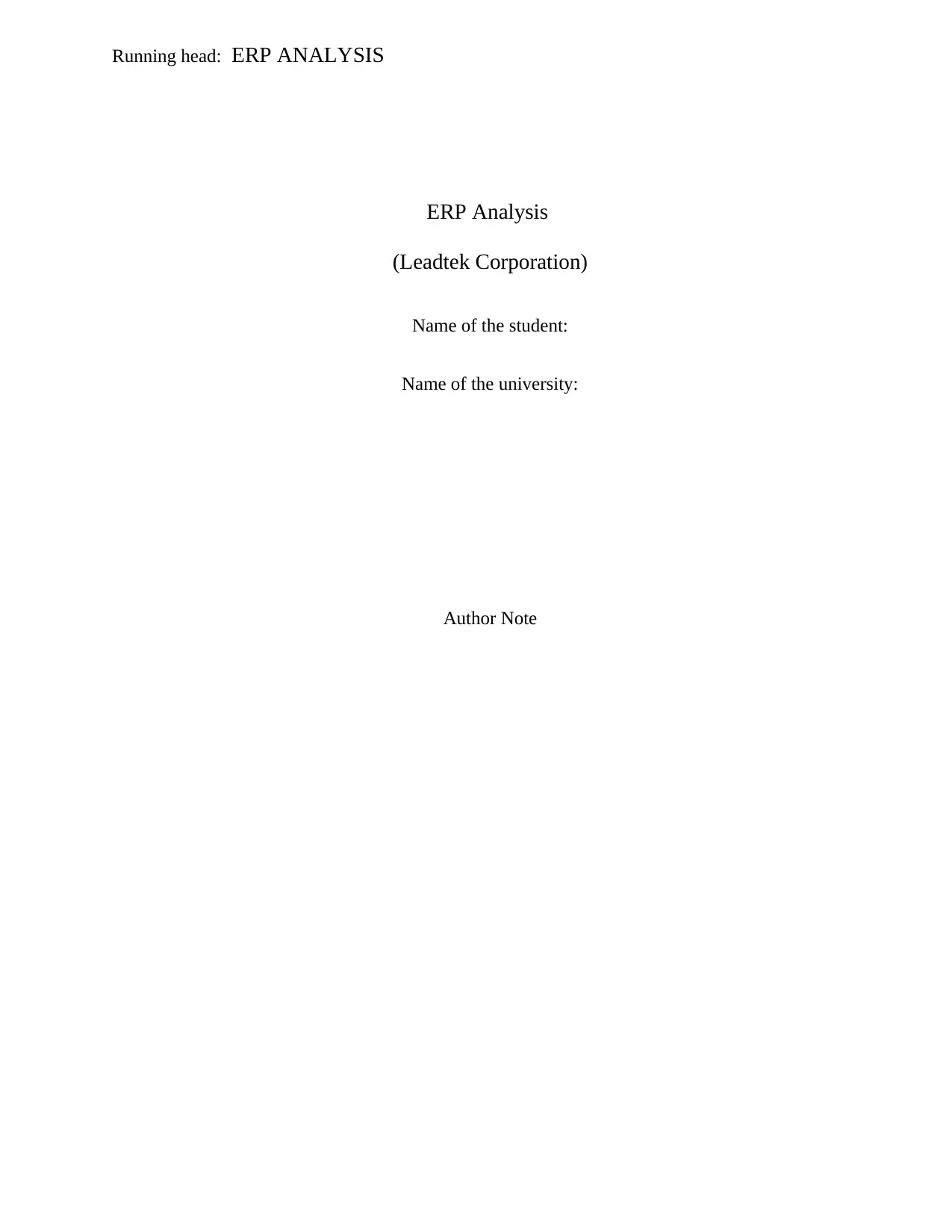
Running head: ERP ANALYSIS
ERP Analysis
(Leadtek Corporation)
Name of the student:
Name of the university:
Author Note
ERP Analysis
(Leadtek Corporation)
Name of the student:
Name of the university:
Author Note
Secure Best Marks with AI Grader
Need help grading? Try our AI Grader for instant feedback on your assignments.
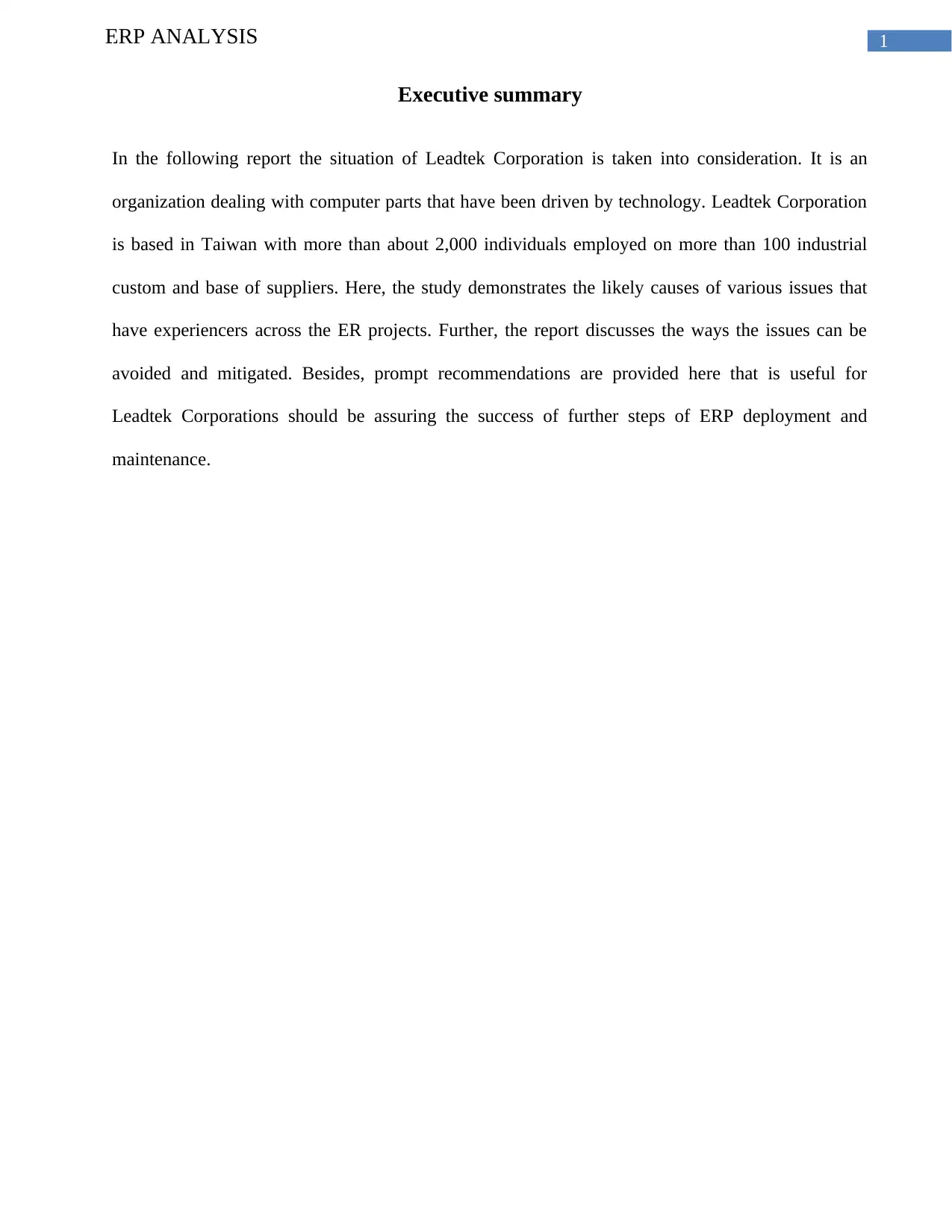
1ERP ANALYSIS
Executive summary
In the following report the situation of Leadtek Corporation is taken into consideration. It is an
organization dealing with computer parts that have been driven by technology. Leadtek Corporation
is based in Taiwan with more than about 2,000 individuals employed on more than 100 industrial
custom and base of suppliers. Here, the study demonstrates the likely causes of various issues that
have experiencers across the ER projects. Further, the report discusses the ways the issues can be
avoided and mitigated. Besides, prompt recommendations are provided here that is useful for
Leadtek Corporations should be assuring the success of further steps of ERP deployment and
maintenance.
Executive summary
In the following report the situation of Leadtek Corporation is taken into consideration. It is an
organization dealing with computer parts that have been driven by technology. Leadtek Corporation
is based in Taiwan with more than about 2,000 individuals employed on more than 100 industrial
custom and base of suppliers. Here, the study demonstrates the likely causes of various issues that
have experiencers across the ER projects. Further, the report discusses the ways the issues can be
avoided and mitigated. Besides, prompt recommendations are provided here that is useful for
Leadtek Corporations should be assuring the success of further steps of ERP deployment and
maintenance.

2ERP ANALYSIS
Table of Contents
Introduction:..........................................................................................................................................3
Likely causes of concerns witnesses by the project of Leadtek Corporation:.......................................3
Show how these problems could have been avoided or mitigated:.......................................................5
An understanding of the legacy system with reference to frameworks:................................................5
A steady source of trusted flow of cash from maintenance and support fees........................................6
Recommendations for Leadtek Corporation in assuring the further phases of ERP applications:........7
Conclusion:............................................................................................................................................8
References:..........................................................................................................................................10
Table of Contents
Introduction:..........................................................................................................................................3
Likely causes of concerns witnesses by the project of Leadtek Corporation:.......................................3
Show how these problems could have been avoided or mitigated:.......................................................5
An understanding of the legacy system with reference to frameworks:................................................5
A steady source of trusted flow of cash from maintenance and support fees........................................6
Recommendations for Leadtek Corporation in assuring the further phases of ERP applications:........7
Conclusion:............................................................................................................................................8
References:..........................................................................................................................................10

3ERP ANALYSIS
Introduction:
In the following study the case of Leadtek Corporation is considered. This is a computer
components company that is technology-driven. This is based in Taiwan has more than 2,000 staffs
on over 100 industrial customers and supplier base that is spread throughout the nation and also
overseas. This report intends to determine the likely causes of the issues that are experienced through
ER projects. It attempts to highlight how the issues could be mitigated and avoided. This delivers
clear suggestions to the extent Leadtek Corporations must assure the success of upcoming phases of
the ERP implementations along with its maintenance.
Likely causes of concerns witnesses by the project of Leadtek Corporation:
Issues started with the localizations. It indicates the capability of ERP in handling the region
nation-specific necessities of levies or taxes and many more. This legacy system has been handing
everything in a perfect way. However, ERP has been a step behind to identify these. The
necessitated tasks rounds that have been cumbersome (Treder et al. 2016). Apart from this, another
source of resistance To ERP originated from Maverick behavior. There have been various
operational sectors that have been informal and never authored officially. Here, while purchasing the
suppliers are been asked to be sending the material despite any formal orders of purchases. These
were regularized post-facto while passing the bill. It was seen that similarities of the sales
department had the practice to extend the dispatches beyond the closing of time. This has been a
month or quarter. This predated the invoices for meeting the ending targets. Moreover, the practices
have been permitted tactically through the departmental managers. However, these were been
frowned on by the top management. Since the ERP never permitted those practices the users have
been performing that for years that resisted the changes. They mentioned that ERP has never been
Introduction:
In the following study the case of Leadtek Corporation is considered. This is a computer
components company that is technology-driven. This is based in Taiwan has more than 2,000 staffs
on over 100 industrial customers and supplier base that is spread throughout the nation and also
overseas. This report intends to determine the likely causes of the issues that are experienced through
ER projects. It attempts to highlight how the issues could be mitigated and avoided. This delivers
clear suggestions to the extent Leadtek Corporations must assure the success of upcoming phases of
the ERP implementations along with its maintenance.
Likely causes of concerns witnesses by the project of Leadtek Corporation:
Issues started with the localizations. It indicates the capability of ERP in handling the region
nation-specific necessities of levies or taxes and many more. This legacy system has been handing
everything in a perfect way. However, ERP has been a step behind to identify these. The
necessitated tasks rounds that have been cumbersome (Treder et al. 2016). Apart from this, another
source of resistance To ERP originated from Maverick behavior. There have been various
operational sectors that have been informal and never authored officially. Here, while purchasing the
suppliers are been asked to be sending the material despite any formal orders of purchases. These
were regularized post-facto while passing the bill. It was seen that similarities of the sales
department had the practice to extend the dispatches beyond the closing of time. This has been a
month or quarter. This predated the invoices for meeting the ending targets. Moreover, the practices
have been permitted tactically through the departmental managers. However, these were been
frowned on by the top management. Since the ERP never permitted those practices the users have
been performing that for years that resisted the changes. They mentioned that ERP has never been
Secure Best Marks with AI Grader
Need help grading? Try our AI Grader for instant feedback on your assignments.
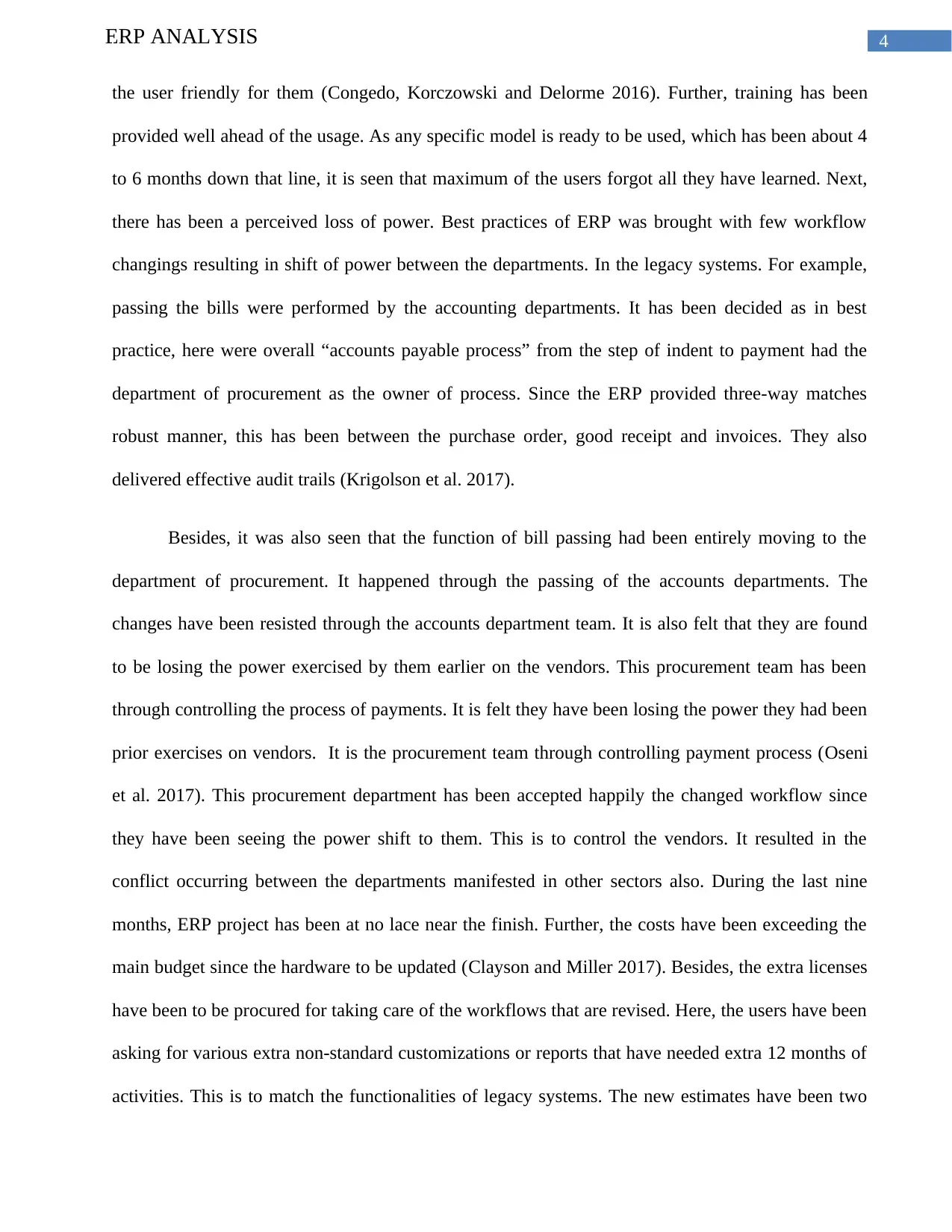
4ERP ANALYSIS
the user friendly for them (Congedo, Korczowski and Delorme 2016). Further, training has been
provided well ahead of the usage. As any specific model is ready to be used, which has been about 4
to 6 months down that line, it is seen that maximum of the users forgot all they have learned. Next,
there has been a perceived loss of power. Best practices of ERP was brought with few workflow
changings resulting in shift of power between the departments. In the legacy systems. For example,
passing the bills were performed by the accounting departments. It has been decided as in best
practice, here were overall “accounts payable process” from the step of indent to payment had the
department of procurement as the owner of process. Since the ERP provided three-way matches
robust manner, this has been between the purchase order, good receipt and invoices. They also
delivered effective audit trails (Krigolson et al. 2017).
Besides, it was also seen that the function of bill passing had been entirely moving to the
department of procurement. It happened through the passing of the accounts departments. The
changes have been resisted through the accounts department team. It is also felt that they are found
to be losing the power exercised by them earlier on the vendors. This procurement team has been
through controlling the process of payments. It is felt they have been losing the power they had been
prior exercises on vendors. It is the procurement team through controlling payment process (Oseni
et al. 2017). This procurement department has been accepted happily the changed workflow since
they have been seeing the power shift to them. This is to control the vendors. It resulted in the
conflict occurring between the departments manifested in other sectors also. During the last nine
months, ERP project has been at no lace near the finish. Further, the costs have been exceeding the
main budget since the hardware to be updated (Clayson and Miller 2017). Besides, the extra licenses
have been to be procured for taking care of the workflows that are revised. Here, the users have been
asking for various extra non-standard customizations or reports that have needed extra 12 months of
activities. This is to match the functionalities of legacy systems. The new estimates have been two
the user friendly for them (Congedo, Korczowski and Delorme 2016). Further, training has been
provided well ahead of the usage. As any specific model is ready to be used, which has been about 4
to 6 months down that line, it is seen that maximum of the users forgot all they have learned. Next,
there has been a perceived loss of power. Best practices of ERP was brought with few workflow
changings resulting in shift of power between the departments. In the legacy systems. For example,
passing the bills were performed by the accounting departments. It has been decided as in best
practice, here were overall “accounts payable process” from the step of indent to payment had the
department of procurement as the owner of process. Since the ERP provided three-way matches
robust manner, this has been between the purchase order, good receipt and invoices. They also
delivered effective audit trails (Krigolson et al. 2017).
Besides, it was also seen that the function of bill passing had been entirely moving to the
department of procurement. It happened through the passing of the accounts departments. The
changes have been resisted through the accounts department team. It is also felt that they are found
to be losing the power exercised by them earlier on the vendors. This procurement team has been
through controlling the process of payments. It is felt they have been losing the power they had been
prior exercises on vendors. It is the procurement team through controlling payment process (Oseni
et al. 2017). This procurement department has been accepted happily the changed workflow since
they have been seeing the power shift to them. This is to control the vendors. It resulted in the
conflict occurring between the departments manifested in other sectors also. During the last nine
months, ERP project has been at no lace near the finish. Further, the costs have been exceeding the
main budget since the hardware to be updated (Clayson and Miller 2017). Besides, the extra licenses
have been to be procured for taking care of the workflows that are revised. Here, the users have been
asking for various extra non-standard customizations or reports that have needed extra 12 months of
activities. This is to match the functionalities of legacy systems. The new estimates have been two
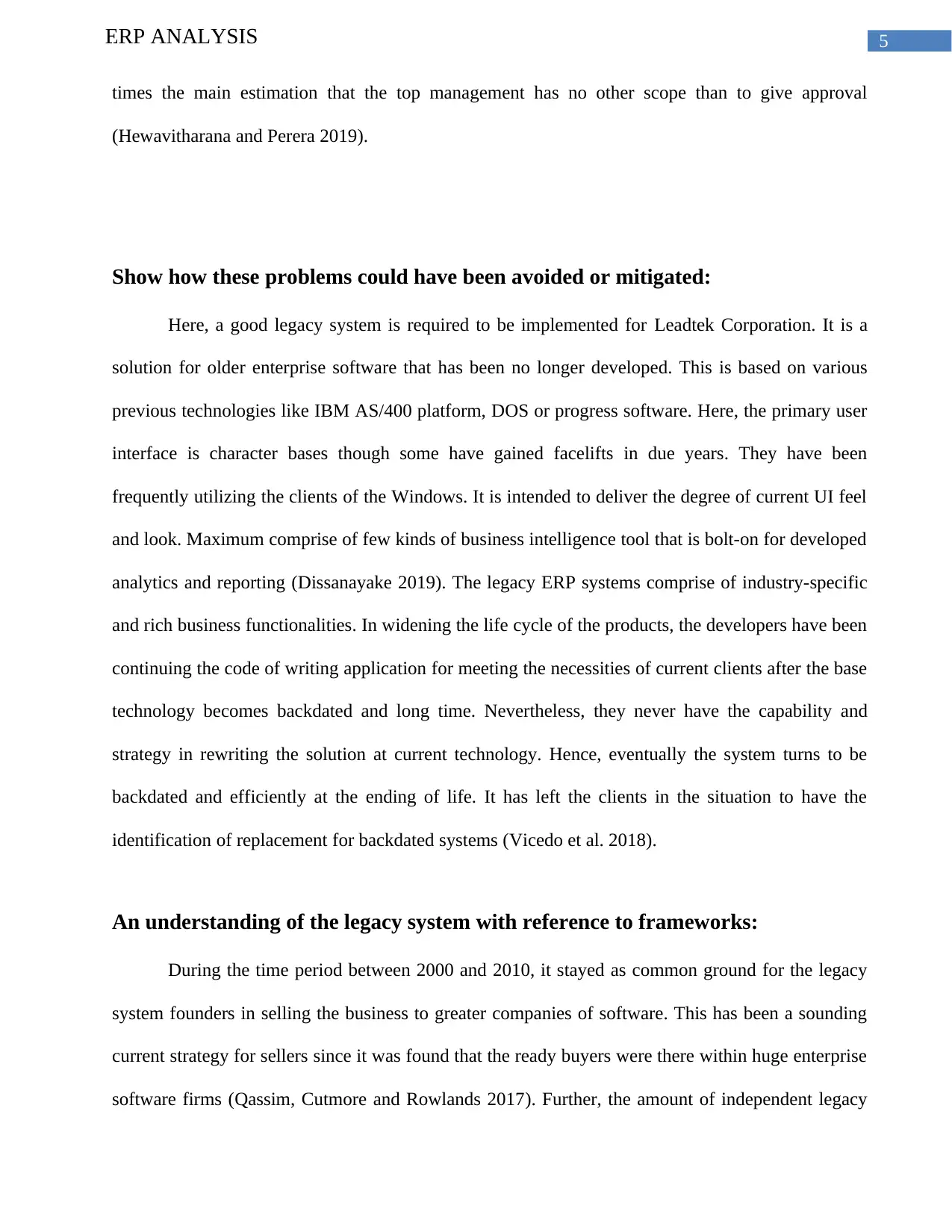
5ERP ANALYSIS
times the main estimation that the top management has no other scope than to give approval
(Hewavitharana and Perera 2019).
Show how these problems could have been avoided or mitigated:
Here, a good legacy system is required to be implemented for Leadtek Corporation. It is a
solution for older enterprise software that has been no longer developed. This is based on various
previous technologies like IBM AS/400 platform, DOS or progress software. Here, the primary user
interface is character bases though some have gained facelifts in due years. They have been
frequently utilizing the clients of the Windows. It is intended to deliver the degree of current UI feel
and look. Maximum comprise of few kinds of business intelligence tool that is bolt-on for developed
analytics and reporting (Dissanayake 2019). The legacy ERP systems comprise of industry-specific
and rich business functionalities. In widening the life cycle of the products, the developers have been
continuing the code of writing application for meeting the necessities of current clients after the base
technology becomes backdated and long time. Nevertheless, they never have the capability and
strategy in rewriting the solution at current technology. Hence, eventually the system turns to be
backdated and efficiently at the ending of life. It has left the clients in the situation to have the
identification of replacement for backdated systems (Vicedo et al. 2018).
An understanding of the legacy system with reference to frameworks:
During the time period between 2000 and 2010, it stayed as common ground for the legacy
system founders in selling the business to greater companies of software. This has been a sounding
current strategy for sellers since it was found that the ready buyers were there within huge enterprise
software firms (Qassim, Cutmore and Rowlands 2017). Further, the amount of independent legacy
times the main estimation that the top management has no other scope than to give approval
(Hewavitharana and Perera 2019).
Show how these problems could have been avoided or mitigated:
Here, a good legacy system is required to be implemented for Leadtek Corporation. It is a
solution for older enterprise software that has been no longer developed. This is based on various
previous technologies like IBM AS/400 platform, DOS or progress software. Here, the primary user
interface is character bases though some have gained facelifts in due years. They have been
frequently utilizing the clients of the Windows. It is intended to deliver the degree of current UI feel
and look. Maximum comprise of few kinds of business intelligence tool that is bolt-on for developed
analytics and reporting (Dissanayake 2019). The legacy ERP systems comprise of industry-specific
and rich business functionalities. In widening the life cycle of the products, the developers have been
continuing the code of writing application for meeting the necessities of current clients after the base
technology becomes backdated and long time. Nevertheless, they never have the capability and
strategy in rewriting the solution at current technology. Hence, eventually the system turns to be
backdated and efficiently at the ending of life. It has left the clients in the situation to have the
identification of replacement for backdated systems (Vicedo et al. 2018).
An understanding of the legacy system with reference to frameworks:
During the time period between 2000 and 2010, it stayed as common ground for the legacy
system founders in selling the business to greater companies of software. This has been a sounding
current strategy for sellers since it was found that the ready buyers were there within huge enterprise
software firms (Qassim, Cutmore and Rowlands 2017). Further, the amount of independent legacy
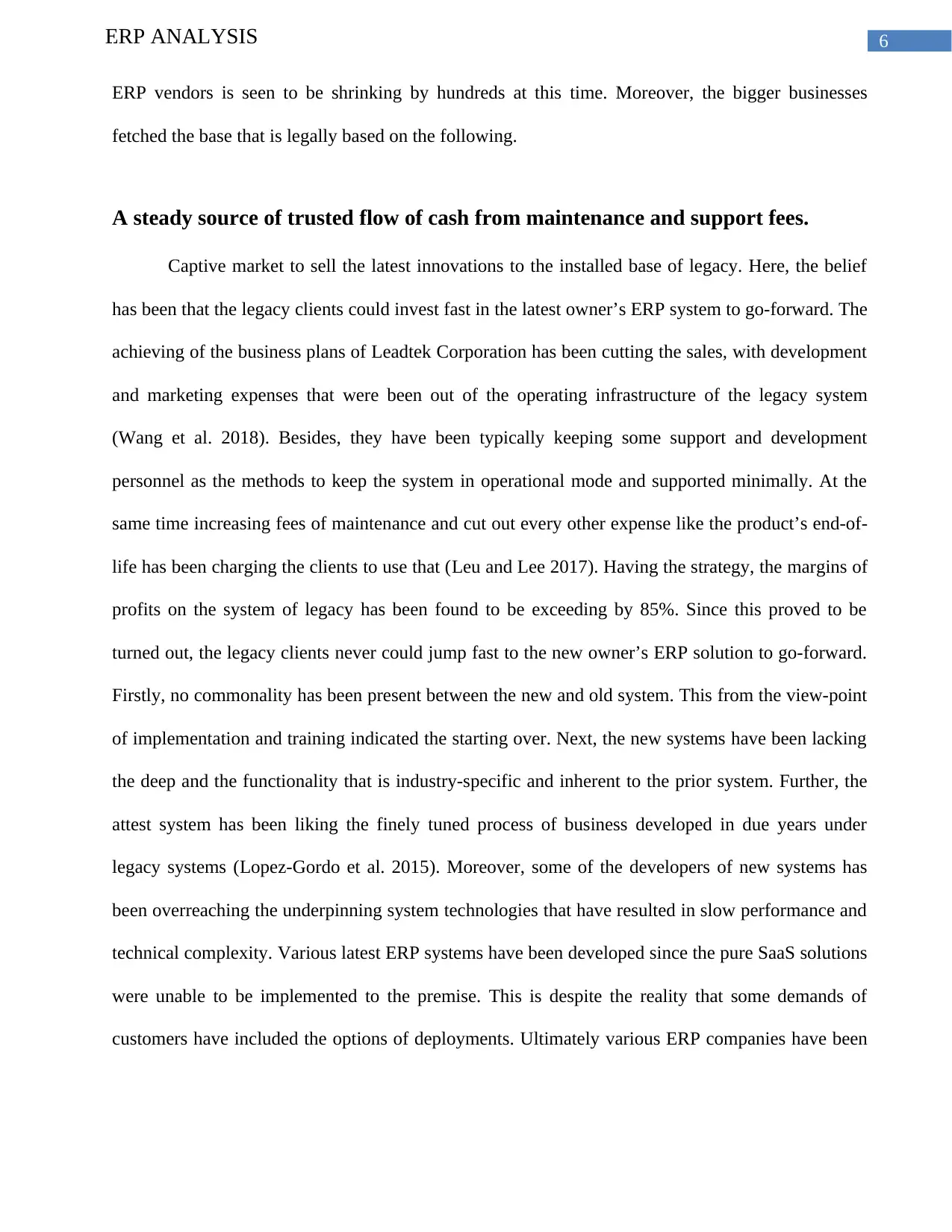
6ERP ANALYSIS
ERP vendors is seen to be shrinking by hundreds at this time. Moreover, the bigger businesses
fetched the base that is legally based on the following.
A steady source of trusted flow of cash from maintenance and support fees.
Captive market to sell the latest innovations to the installed base of legacy. Here, the belief
has been that the legacy clients could invest fast in the latest owner’s ERP system to go-forward. The
achieving of the business plans of Leadtek Corporation has been cutting the sales, with development
and marketing expenses that were been out of the operating infrastructure of the legacy system
(Wang et al. 2018). Besides, they have been typically keeping some support and development
personnel as the methods to keep the system in operational mode and supported minimally. At the
same time increasing fees of maintenance and cut out every other expense like the product’s end-of-
life has been charging the clients to use that (Leu and Lee 2017). Having the strategy, the margins of
profits on the system of legacy has been found to be exceeding by 85%. Since this proved to be
turned out, the legacy clients never could jump fast to the new owner’s ERP solution to go-forward.
Firstly, no commonality has been present between the new and old system. This from the view-point
of implementation and training indicated the starting over. Next, the new systems have been lacking
the deep and the functionality that is industry-specific and inherent to the prior system. Further, the
attest system has been liking the finely tuned process of business developed in due years under
legacy systems (Lopez-Gordo et al. 2015). Moreover, some of the developers of new systems has
been overreaching the underpinning system technologies that have resulted in slow performance and
technical complexity. Various latest ERP systems have been developed since the pure SaaS solutions
were unable to be implemented to the premise. This is despite the reality that some demands of
customers have included the options of deployments. Ultimately various ERP companies have been
ERP vendors is seen to be shrinking by hundreds at this time. Moreover, the bigger businesses
fetched the base that is legally based on the following.
A steady source of trusted flow of cash from maintenance and support fees.
Captive market to sell the latest innovations to the installed base of legacy. Here, the belief
has been that the legacy clients could invest fast in the latest owner’s ERP system to go-forward. The
achieving of the business plans of Leadtek Corporation has been cutting the sales, with development
and marketing expenses that were been out of the operating infrastructure of the legacy system
(Wang et al. 2018). Besides, they have been typically keeping some support and development
personnel as the methods to keep the system in operational mode and supported minimally. At the
same time increasing fees of maintenance and cut out every other expense like the product’s end-of-
life has been charging the clients to use that (Leu and Lee 2017). Having the strategy, the margins of
profits on the system of legacy has been found to be exceeding by 85%. Since this proved to be
turned out, the legacy clients never could jump fast to the new owner’s ERP solution to go-forward.
Firstly, no commonality has been present between the new and old system. This from the view-point
of implementation and training indicated the starting over. Next, the new systems have been lacking
the deep and the functionality that is industry-specific and inherent to the prior system. Further, the
attest system has been liking the finely tuned process of business developed in due years under
legacy systems (Lopez-Gordo et al. 2015). Moreover, some of the developers of new systems has
been overreaching the underpinning system technologies that have resulted in slow performance and
technical complexity. Various latest ERP systems have been developed since the pure SaaS solutions
were unable to be implemented to the premise. This is despite the reality that some demands of
customers have included the options of deployments. Ultimately various ERP companies have been
Paraphrase This Document
Need a fresh take? Get an instant paraphrase of this document with our AI Paraphraser
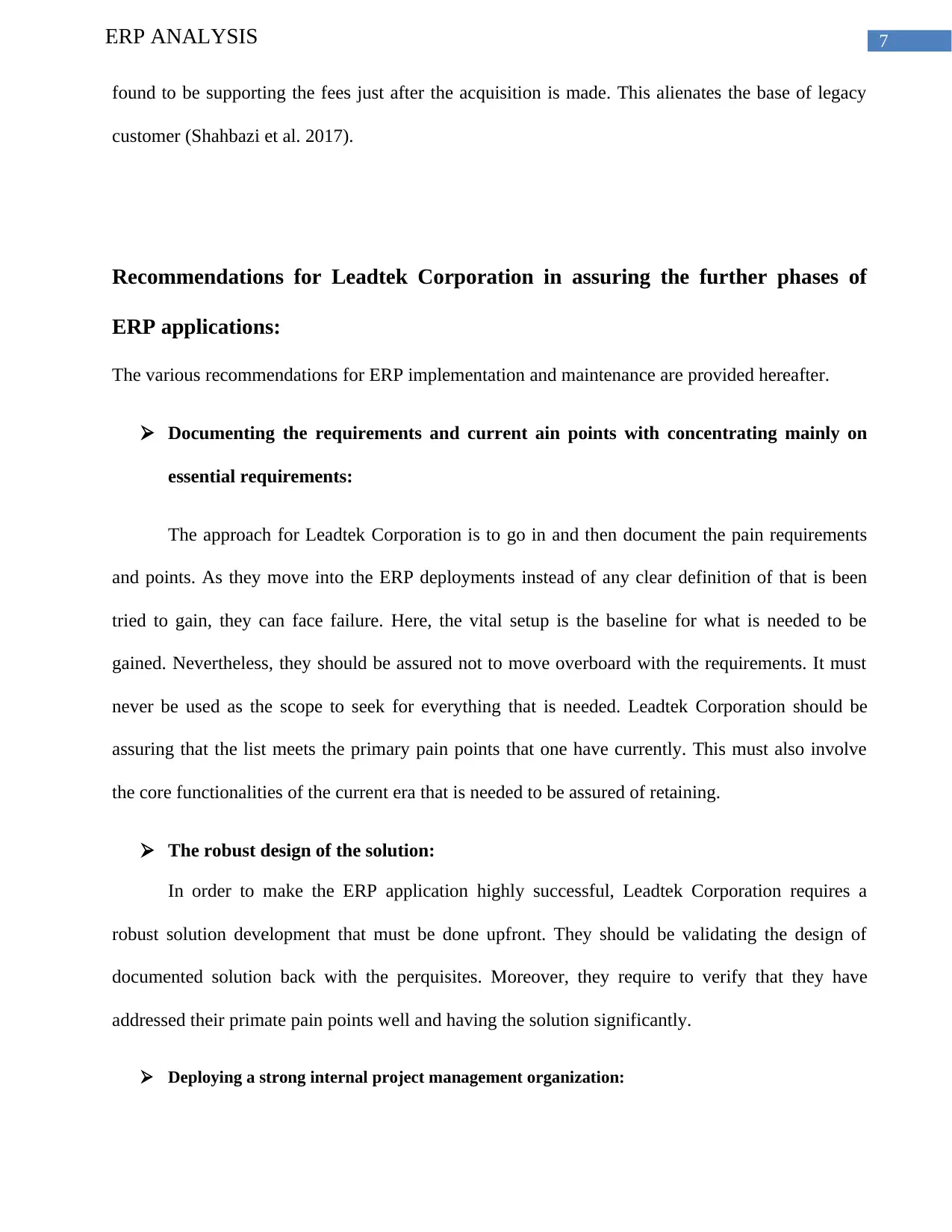
7ERP ANALYSIS
found to be supporting the fees just after the acquisition is made. This alienates the base of legacy
customer (Shahbazi et al. 2017).
Recommendations for Leadtek Corporation in assuring the further phases of
ERP applications:
The various recommendations for ERP implementation and maintenance are provided hereafter.
Documenting the requirements and current ain points with concentrating mainly on
essential requirements:
The approach for Leadtek Corporation is to go in and then document the pain requirements
and points. As they move into the ERP deployments instead of any clear definition of that is been
tried to gain, they can face failure. Here, the vital setup is the baseline for what is needed to be
gained. Nevertheless, they should be assured not to move overboard with the requirements. It must
never be used as the scope to seek for everything that is needed. Leadtek Corporation should be
assuring that the list meets the primary pain points that one have currently. This must also involve
the core functionalities of the current era that is needed to be assured of retaining.
The robust design of the solution:
In order to make the ERP application highly successful, Leadtek Corporation requires a
robust solution development that must be done upfront. They should be validating the design of
documented solution back with the perquisites. Moreover, they require to verify that they have
addressed their primate pain points well and having the solution significantly.
Deploying a strong internal project management organization:
found to be supporting the fees just after the acquisition is made. This alienates the base of legacy
customer (Shahbazi et al. 2017).
Recommendations for Leadtek Corporation in assuring the further phases of
ERP applications:
The various recommendations for ERP implementation and maintenance are provided hereafter.
Documenting the requirements and current ain points with concentrating mainly on
essential requirements:
The approach for Leadtek Corporation is to go in and then document the pain requirements
and points. As they move into the ERP deployments instead of any clear definition of that is been
tried to gain, they can face failure. Here, the vital setup is the baseline for what is needed to be
gained. Nevertheless, they should be assured not to move overboard with the requirements. It must
never be used as the scope to seek for everything that is needed. Leadtek Corporation should be
assuring that the list meets the primary pain points that one have currently. This must also involve
the core functionalities of the current era that is needed to be assured of retaining.
The robust design of the solution:
In order to make the ERP application highly successful, Leadtek Corporation requires a
robust solution development that must be done upfront. They should be validating the design of
documented solution back with the perquisites. Moreover, they require to verify that they have
addressed their primate pain points well and having the solution significantly.
Deploying a strong internal project management organization:
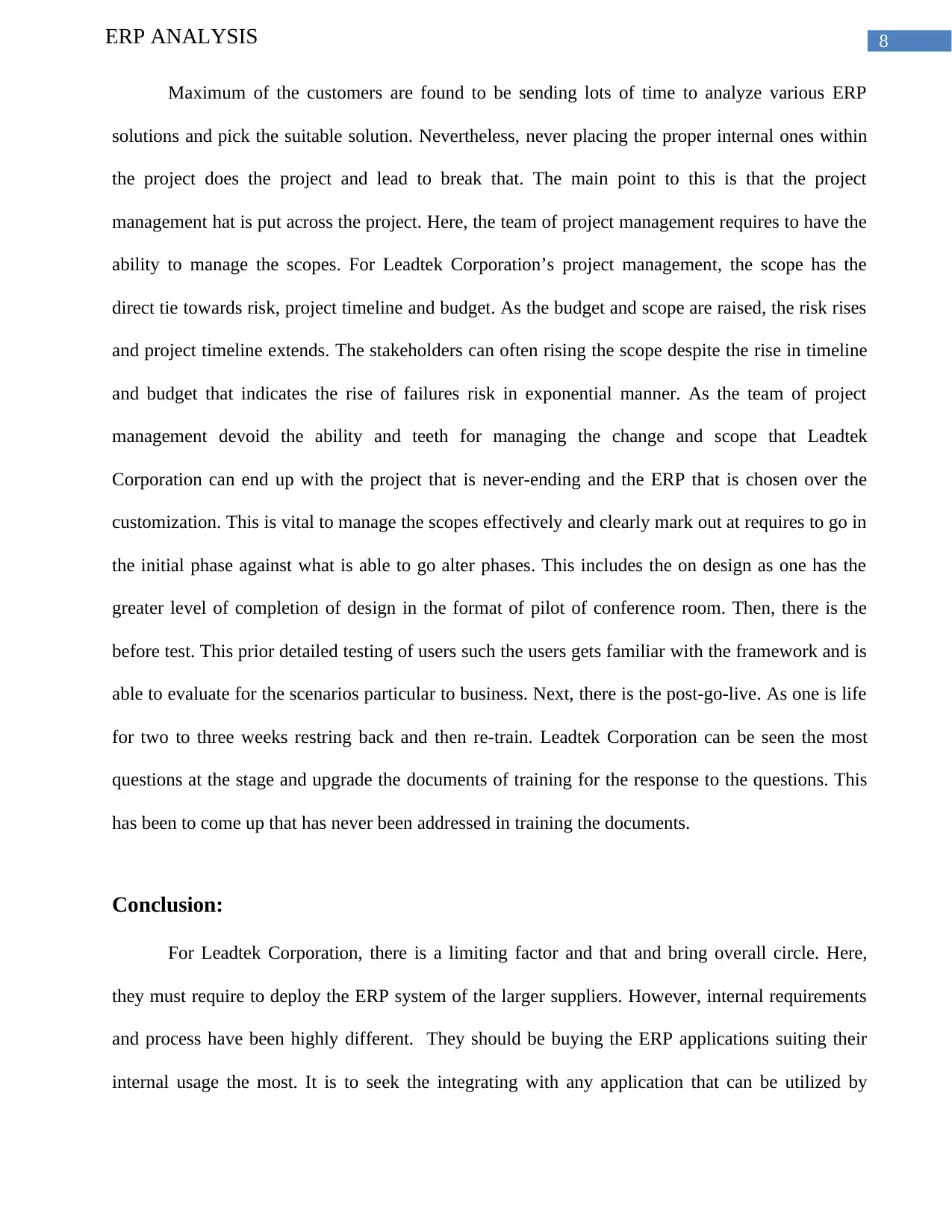
8ERP ANALYSIS
Maximum of the customers are found to be sending lots of time to analyze various ERP
solutions and pick the suitable solution. Nevertheless, never placing the proper internal ones within
the project does the project and lead to break that. The main point to this is that the project
management hat is put across the project. Here, the team of project management requires to have the
ability to manage the scopes. For Leadtek Corporation’s project management, the scope has the
direct tie towards risk, project timeline and budget. As the budget and scope are raised, the risk rises
and project timeline extends. The stakeholders can often rising the scope despite the rise in timeline
and budget that indicates the rise of failures risk in exponential manner. As the team of project
management devoid the ability and teeth for managing the change and scope that Leadtek
Corporation can end up with the project that is never-ending and the ERP that is chosen over the
customization. This is vital to manage the scopes effectively and clearly mark out at requires to go in
the initial phase against what is able to go alter phases. This includes the on design as one has the
greater level of completion of design in the format of pilot of conference room. Then, there is the
before test. This prior detailed testing of users such the users gets familiar with the framework and is
able to evaluate for the scenarios particular to business. Next, there is the post-go-live. As one is life
for two to three weeks restring back and then re-train. Leadtek Corporation can be seen the most
questions at the stage and upgrade the documents of training for the response to the questions. This
has been to come up that has never been addressed in training the documents.
Conclusion:
For Leadtek Corporation, there is a limiting factor and that and bring overall circle. Here,
they must require to deploy the ERP system of the larger suppliers. However, internal requirements
and process have been highly different. They should be buying the ERP applications suiting their
internal usage the most. It is to seek the integrating with any application that can be utilized by
Maximum of the customers are found to be sending lots of time to analyze various ERP
solutions and pick the suitable solution. Nevertheless, never placing the proper internal ones within
the project does the project and lead to break that. The main point to this is that the project
management hat is put across the project. Here, the team of project management requires to have the
ability to manage the scopes. For Leadtek Corporation’s project management, the scope has the
direct tie towards risk, project timeline and budget. As the budget and scope are raised, the risk rises
and project timeline extends. The stakeholders can often rising the scope despite the rise in timeline
and budget that indicates the rise of failures risk in exponential manner. As the team of project
management devoid the ability and teeth for managing the change and scope that Leadtek
Corporation can end up with the project that is never-ending and the ERP that is chosen over the
customization. This is vital to manage the scopes effectively and clearly mark out at requires to go in
the initial phase against what is able to go alter phases. This includes the on design as one has the
greater level of completion of design in the format of pilot of conference room. Then, there is the
before test. This prior detailed testing of users such the users gets familiar with the framework and is
able to evaluate for the scenarios particular to business. Next, there is the post-go-live. As one is life
for two to three weeks restring back and then re-train. Leadtek Corporation can be seen the most
questions at the stage and upgrade the documents of training for the response to the questions. This
has been to come up that has never been addressed in training the documents.
Conclusion:
For Leadtek Corporation, there is a limiting factor and that and bring overall circle. Here,
they must require to deploy the ERP system of the larger suppliers. However, internal requirements
and process have been highly different. They should be buying the ERP applications suiting their
internal usage the most. It is to seek the integrating with any application that can be utilized by
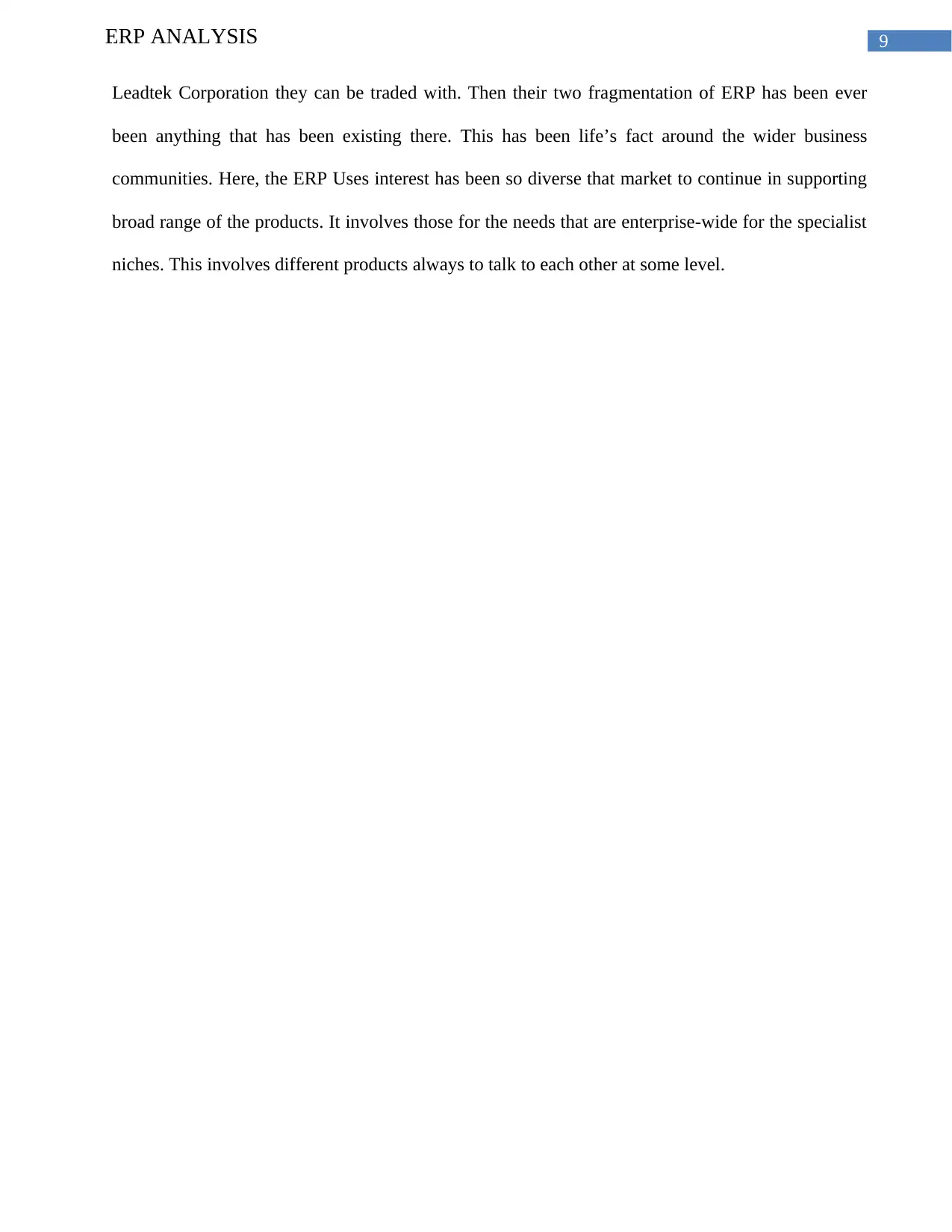
9ERP ANALYSIS
Leadtek Corporation they can be traded with. Then their two fragmentation of ERP has been ever
been anything that has been existing there. This has been life’s fact around the wider business
communities. Here, the ERP Uses interest has been so diverse that market to continue in supporting
broad range of the products. It involves those for the needs that are enterprise-wide for the specialist
niches. This involves different products always to talk to each other at some level.
Leadtek Corporation they can be traded with. Then their two fragmentation of ERP has been ever
been anything that has been existing there. This has been life’s fact around the wider business
communities. Here, the ERP Uses interest has been so diverse that market to continue in supporting
broad range of the products. It involves those for the needs that are enterprise-wide for the specialist
niches. This involves different products always to talk to each other at some level.
Secure Best Marks with AI Grader
Need help grading? Try our AI Grader for instant feedback on your assignments.
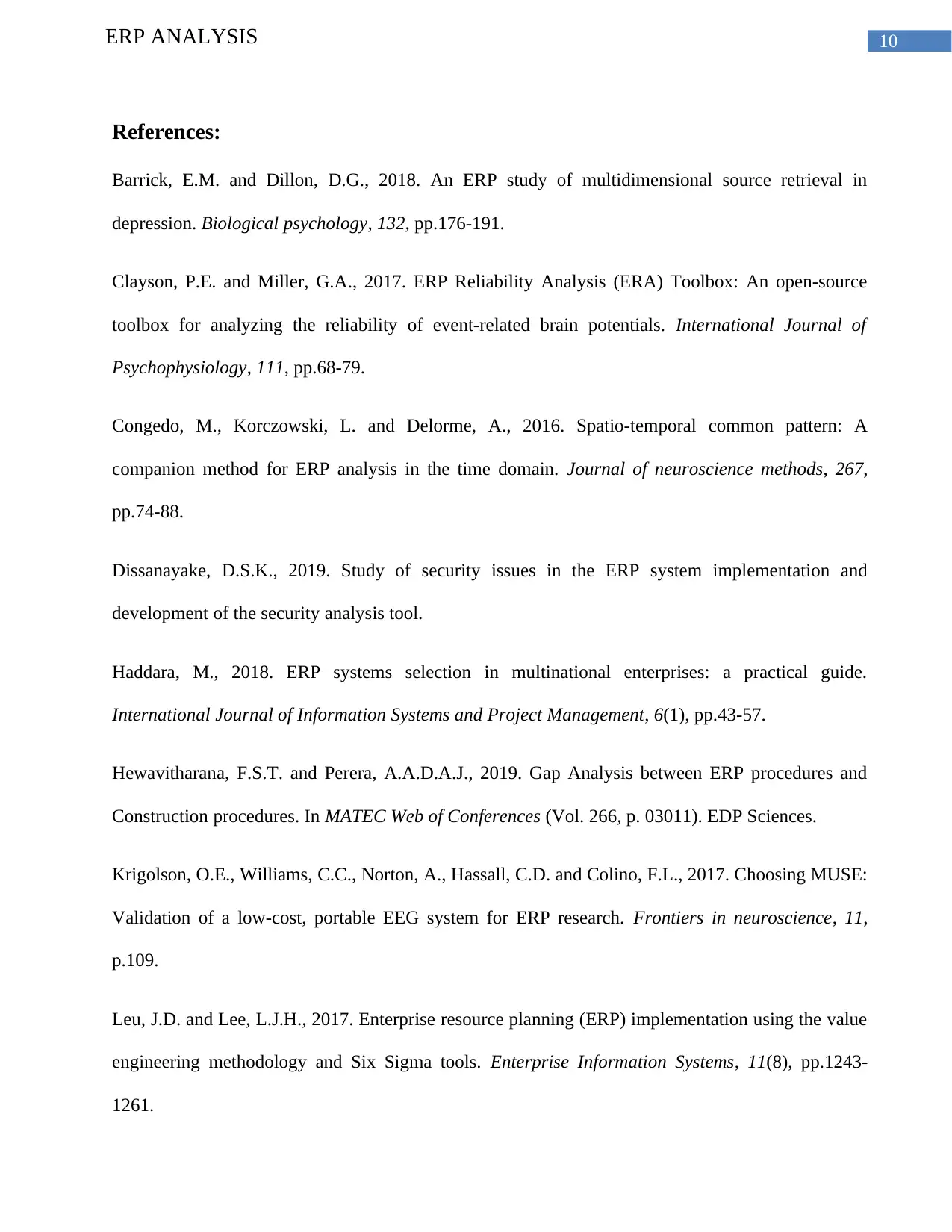
10ERP ANALYSIS
References:
Barrick, E.M. and Dillon, D.G., 2018. An ERP study of multidimensional source retrieval in
depression. Biological psychology, 132, pp.176-191.
Clayson, P.E. and Miller, G.A., 2017. ERP Reliability Analysis (ERA) Toolbox: An open-source
toolbox for analyzing the reliability of event-related brain potentials. International Journal of
Psychophysiology, 111, pp.68-79.
Congedo, M., Korczowski, L. and Delorme, A., 2016. Spatio-temporal common pattern: A
companion method for ERP analysis in the time domain. Journal of neuroscience methods, 267,
pp.74-88.
Dissanayake, D.S.K., 2019. Study of security issues in the ERP system implementation and
development of the security analysis tool.
Haddara, M., 2018. ERP systems selection in multinational enterprises: a practical guide.
International Journal of Information Systems and Project Management, 6(1), pp.43-57.
Hewavitharana, F.S.T. and Perera, A.A.D.A.J., 2019. Gap Analysis between ERP procedures and
Construction procedures. In MATEC Web of Conferences (Vol. 266, p. 03011). EDP Sciences.
Krigolson, O.E., Williams, C.C., Norton, A., Hassall, C.D. and Colino, F.L., 2017. Choosing MUSE:
Validation of a low-cost, portable EEG system for ERP research. Frontiers in neuroscience, 11,
p.109.
Leu, J.D. and Lee, L.J.H., 2017. Enterprise resource planning (ERP) implementation using the value
engineering methodology and Six Sigma tools. Enterprise Information Systems, 11(8), pp.1243-
1261.
References:
Barrick, E.M. and Dillon, D.G., 2018. An ERP study of multidimensional source retrieval in
depression. Biological psychology, 132, pp.176-191.
Clayson, P.E. and Miller, G.A., 2017. ERP Reliability Analysis (ERA) Toolbox: An open-source
toolbox for analyzing the reliability of event-related brain potentials. International Journal of
Psychophysiology, 111, pp.68-79.
Congedo, M., Korczowski, L. and Delorme, A., 2016. Spatio-temporal common pattern: A
companion method for ERP analysis in the time domain. Journal of neuroscience methods, 267,
pp.74-88.
Dissanayake, D.S.K., 2019. Study of security issues in the ERP system implementation and
development of the security analysis tool.
Haddara, M., 2018. ERP systems selection in multinational enterprises: a practical guide.
International Journal of Information Systems and Project Management, 6(1), pp.43-57.
Hewavitharana, F.S.T. and Perera, A.A.D.A.J., 2019. Gap Analysis between ERP procedures and
Construction procedures. In MATEC Web of Conferences (Vol. 266, p. 03011). EDP Sciences.
Krigolson, O.E., Williams, C.C., Norton, A., Hassall, C.D. and Colino, F.L., 2017. Choosing MUSE:
Validation of a low-cost, portable EEG system for ERP research. Frontiers in neuroscience, 11,
p.109.
Leu, J.D. and Lee, L.J.H., 2017. Enterprise resource planning (ERP) implementation using the value
engineering methodology and Six Sigma tools. Enterprise Information Systems, 11(8), pp.1243-
1261.
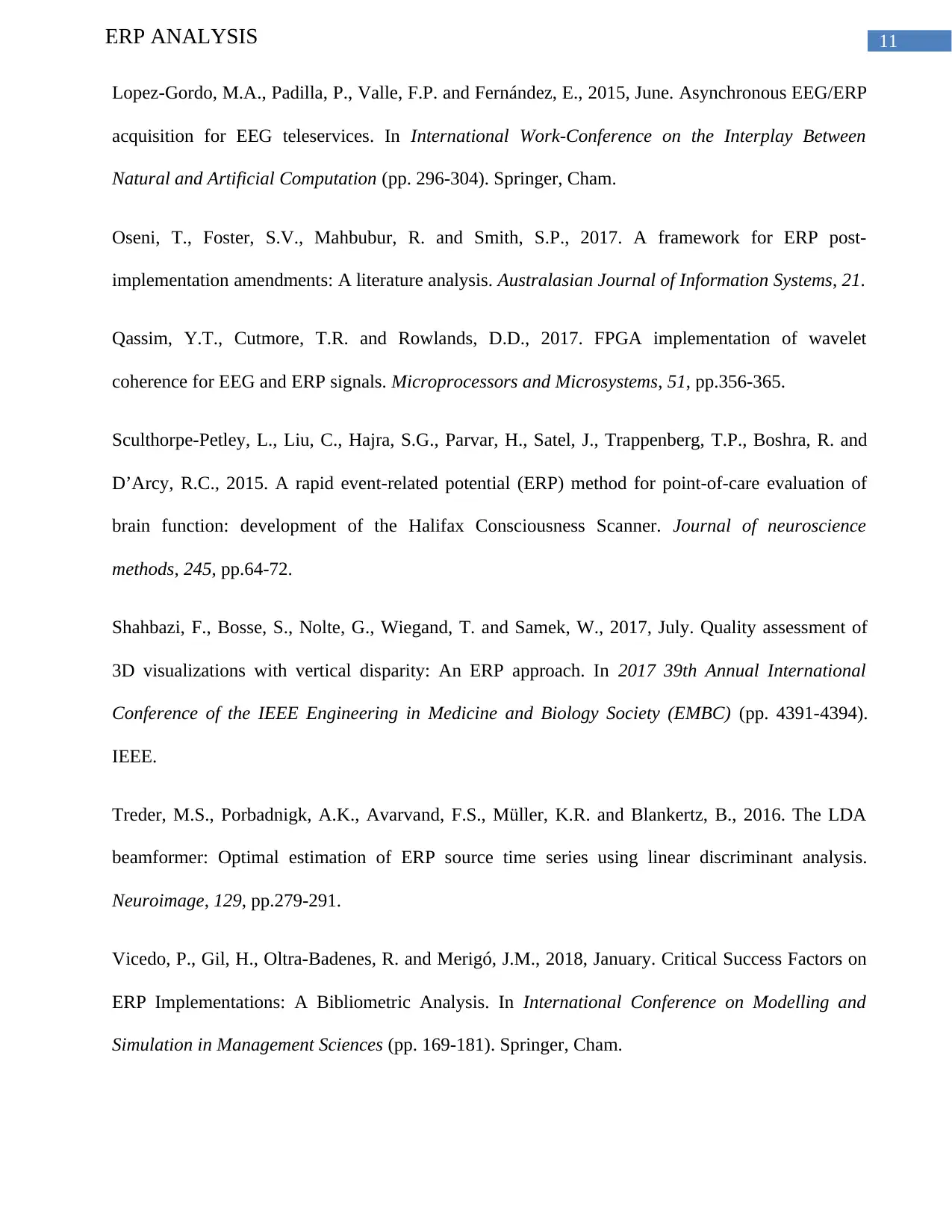
11ERP ANALYSIS
Lopez-Gordo, M.A., Padilla, P., Valle, F.P. and Fernández, E., 2015, June. Asynchronous EEG/ERP
acquisition for EEG teleservices. In International Work-Conference on the Interplay Between
Natural and Artificial Computation (pp. 296-304). Springer, Cham.
Oseni, T., Foster, S.V., Mahbubur, R. and Smith, S.P., 2017. A framework for ERP post-
implementation amendments: A literature analysis. Australasian Journal of Information Systems, 21.
Qassim, Y.T., Cutmore, T.R. and Rowlands, D.D., 2017. FPGA implementation of wavelet
coherence for EEG and ERP signals. Microprocessors and Microsystems, 51, pp.356-365.
Sculthorpe-Petley, L., Liu, C., Hajra, S.G., Parvar, H., Satel, J., Trappenberg, T.P., Boshra, R. and
D’Arcy, R.C., 2015. A rapid event-related potential (ERP) method for point-of-care evaluation of
brain function: development of the Halifax Consciousness Scanner. Journal of neuroscience
methods, 245, pp.64-72.
Shahbazi, F., Bosse, S., Nolte, G., Wiegand, T. and Samek, W., 2017, July. Quality assessment of
3D visualizations with vertical disparity: An ERP approach. In 2017 39th Annual International
Conference of the IEEE Engineering in Medicine and Biology Society (EMBC) (pp. 4391-4394).
IEEE.
Treder, M.S., Porbadnigk, A.K., Avarvand, F.S., Müller, K.R. and Blankertz, B., 2016. The LDA
beamformer: Optimal estimation of ERP source time series using linear discriminant analysis.
Neuroimage, 129, pp.279-291.
Vicedo, P., Gil, H., Oltra-Badenes, R. and Merigó, J.M., 2018, January. Critical Success Factors on
ERP Implementations: A Bibliometric Analysis. In International Conference on Modelling and
Simulation in Management Sciences (pp. 169-181). Springer, Cham.
Lopez-Gordo, M.A., Padilla, P., Valle, F.P. and Fernández, E., 2015, June. Asynchronous EEG/ERP
acquisition for EEG teleservices. In International Work-Conference on the Interplay Between
Natural and Artificial Computation (pp. 296-304). Springer, Cham.
Oseni, T., Foster, S.V., Mahbubur, R. and Smith, S.P., 2017. A framework for ERP post-
implementation amendments: A literature analysis. Australasian Journal of Information Systems, 21.
Qassim, Y.T., Cutmore, T.R. and Rowlands, D.D., 2017. FPGA implementation of wavelet
coherence for EEG and ERP signals. Microprocessors and Microsystems, 51, pp.356-365.
Sculthorpe-Petley, L., Liu, C., Hajra, S.G., Parvar, H., Satel, J., Trappenberg, T.P., Boshra, R. and
D’Arcy, R.C., 2015. A rapid event-related potential (ERP) method for point-of-care evaluation of
brain function: development of the Halifax Consciousness Scanner. Journal of neuroscience
methods, 245, pp.64-72.
Shahbazi, F., Bosse, S., Nolte, G., Wiegand, T. and Samek, W., 2017, July. Quality assessment of
3D visualizations with vertical disparity: An ERP approach. In 2017 39th Annual International
Conference of the IEEE Engineering in Medicine and Biology Society (EMBC) (pp. 4391-4394).
IEEE.
Treder, M.S., Porbadnigk, A.K., Avarvand, F.S., Müller, K.R. and Blankertz, B., 2016. The LDA
beamformer: Optimal estimation of ERP source time series using linear discriminant analysis.
Neuroimage, 129, pp.279-291.
Vicedo, P., Gil, H., Oltra-Badenes, R. and Merigó, J.M., 2018, January. Critical Success Factors on
ERP Implementations: A Bibliometric Analysis. In International Conference on Modelling and
Simulation in Management Sciences (pp. 169-181). Springer, Cham.
1 out of 12
Your All-in-One AI-Powered Toolkit for Academic Success.
+13062052269
info@desklib.com
Available 24*7 on WhatsApp / Email
![[object Object]](/_next/static/media/star-bottom.7253800d.svg)
Unlock your academic potential
© 2024 | Zucol Services PVT LTD | All rights reserved.


